A History of Cane Self-Defense in America: 1798-1930
A History of Cane Self-Defense in America:
1798-1930
During the eighteenth, nineteenth, and early twentieth centuries, America could be a dangerous place, and knowledge of self-defense was often necessary for use in both urban and rural environments. To those ends, fencing masters and instructors often modified and applied fencing techniques to the cane or walking stick, creating their own systems of self-defense. This article proposes to look at various methods of cane defense, taught by fencing masters and instructors, that were specifically intended for practical use in self-defense encounters in the everyday world.
The individuals who taught such techniques hailed from a variety of backgrounds—from England, France, Italy, Ireland, Poland, Belgium, Denmark, and Germany—and specifically discussed the cane’s efficacy in defending against other potentially deadly weapons such as the sword, sword-cane, stick, dirk, Spanish knife, Bowie knife, bayonet-rifle, boarding pike, and revolver. These fencing methods were applied to canes both with and without hooks, and included techniques designed to defend against multiple attackers, variously utilizing both single and double-handed grips.
In some cases, these methods of defense were influenced by one or more other formalized systems of saber, broadsword, singlestick, bayonet, French la canne, and canne royale. Although combative methods of singlestick (that is, the training weapon), la canne, canne royale, and Irish shillelagh were also used in America, and may have impacted these techniques, methods belonging explicitly to those systems are beyond the scope of this article. Moreover, they have already been written about extensively, and can be read about here and here.
Historical Background:
Eighteenth Century America and Europe
An extensive study of colonial American fencing schools known to exist up to the year 1800 suggests that instruction in practical cane defense was not offered in the United States until 1798. Prior to this time, as the sword was still worn and carried as a personal sidearm as well as an article of dress, the walking-stick may have been regarded as a superfluous instrument for self-defense—even though it, too, was carried as a common article. That does not mean, however, that sticks were never used for combative purposes. Games, or combat sports, of “cudgeling” often made their appearances at fairs and gatherings in colonial America, and “cudgels” were often used as non-lethal instruments for settling disputes. Fencing instructors often used the cane or singlestick as a training tool for the backsword, broadsword and sabre in various salles des armes. The following crude illustration, sketched by Sir Benjamin Thompson, depicts young fencers training with singlesticks in the school of the Boston-based Scottish fencing instructor Donald McAlpine, and is currently the earliest known illustration of fencing technique in America:
By contrast, during the 1730s, authors in Europe were already writing of applying fencing theory to the cane or walking stick. In 1736, the French fencing master P. F. Girard wrote of using the cane in conjunction with the sword as an auxiliary weapon—that is, wielded in place of the dagger. And in 1771, British fencing instructor Andrew Lonnergan wrote,
“If your desire still leads you after a knowledge of the use of any other weapon, I would prefer that of our English broad, or back-sword, to dagger, lance, cloak, or dark-lanthorn fighting; for being only armed with a stick or a cane, when insulted or attacked, it would be very needless to seek for any of those instruments of cowardly defence, whilst you may disengage yourself from even a superior weapon by the one you undesignedly carry, especially when furnished with, some lessons of its use.”
Lonnergan also explains how the cane is to be used differently than the sword:
“If your weapon be blunt, such as a cane or stick, either batter or whip when you defend, and intend this cut so that you may have more room for your blow and that it may be more powerful.”
During this same period, other European fencers were known to wield their canes in self-defense when necessary. In the second volume of The Reminiscences of Henry Angelo, the author describes how his father, the renowned fencing master Domenico Angelo, successfully used his cane to defend against the attack of a stick-wielding Irishman named Redman, ultimately “breaking” the latter’s head. Likewise, in Domenico’s seminal 1787 work, The School of Fencing, the author records the following techniques:
“In case of need, one might defend one’s self against a sword with a cane and cloak; for after having parried a thrust of the sword with a cane, one should close in at the same time, without quitting his blade, and cover his head with the cloak. To perform this operation well, one ought to be well skilled in fencing, very cool and resolute.” (p. 97)
The Chevalier Saint-Georges, one of the most famous fencers of the eighteenth century, also employed the use of the cane or walking-stick in an encounter with multiple adversaries, as reported in The Journal General de France on February 23, 1790:
“The Chevalier was peacefully walking to Greenwich one night where he was going to make music in a house where he was awaited when he was suddenly attacked by four men armed with pistols. Nevertheless he managed to drive them off with the help of his stick.”
Taking such European sources into consideration, it is possible that instruction in cane self-defense was also offered in America during the middle and late eighteenth century. However, exactly what form this may have taken, or to what degree it may have existed, available evidence is not yet forthcoming.
ROBERT HEWES (1751-1830)
“He teaches the art of Bone Breaking—genteely.”
In the United States, the first fencing instructor that we know of to publicly advertise instruction in cane defense was Robert Hewes, a native of Boston, Massachusetts. Described by his contemporaries as an “extraordinary” and “ingenious” man, Hewes engaged in a number of professions, including glass-making (for which he became renowned), hog-butchery, hardware retail, soap making, and glue manufacturing. He was also described by the Boston press as a surgeon, as well as a “celebrated bone-setter and fencing master.” In acknowledgement of this fact, Hewes hung a sign outside his residence which humorously read, “Bone breaker and bone-setter.” According to Hewes himself, his training in fencing began about 1770, at which time he entered the school of the aforementioned Donald McAlpine. In 1808, Hewes recounted:
I do understand what the Broad Sword is scientifically; having learnt it of the famous [DONALD MCALPIN], a Scotch Highlander, above thirty eight years ago; and I have had the honor and pleasure of teaching it to many of the Officers of our Revolutionary Army, in Roxbury and Cambridge, in the year 1775—and have done it at times, ever since.
During the 1770s, Hewes was also a member of the secret revolutionary society, the Sons of Liberty. At this time, an incident occurred involving Hewes’ first cousin, George Robert Twelves Hewes, which may very well have impressed upon Robert the cane’s efficacy as a weapon, and the necessity for civilian self-defense training. The memoir of George (who later became famed as one of the oldest survivors of the Boston Tea Party and Boston Massacre) refers to “Robert Hewes, my cousin” and recounts the following incident, which occurred shortly after the Boston massacre:
“One day…as I was returning from dinner, I met a man by the name of John Malcom, who was a custom-house officer, and a small boy, pushing his sled along, before him; and just as I was passing the boy, he said to Malcom, what, sir, did you throw my chips into the snow for, yesterday? Upon which Malcom angrily replied, do you speak to me, you rascal; and, as he raised a cane he had in his hand, aiming it at the head of the boy, I spoke to Malcom, and said to him, you are not about to strike that boy with your cudgel, you may kill him; upon my saying that, he was suddenly diverted from the boy, and turning upon me, says, you d—d rascal, do you presume too, to speak to me? I replied to him, I am no rascal, sir, be it known to you; whereupon he struck me across the head with his cane, and knocked me down, and by the blow cut a hole in my hat two inches in length.”
While his attacker was promptly pursued, flogged, tarred and feathered, the unconscious Hewes was conveyed to the noted Doctor Joseph Warren, who dressed his wound and told him upon awakening, “it can be considered no misfortune that [you] had a thick skull, for had not yours been very strong, said he, it would have been broke; you have come within a hair’s breath of loosing your life.”
The increasing local mob mentality, as well as the profusion of gang warfare (involving clubs, staves, and swords) in eighteenth century Boston, may have further convinced Robert Hewes of the need to make self-defense training available to civilians. A relative later recounted that Hewes “taught the Scotch Highland broad sword to the officers of the army in the Revolution.” However, as far as we know, Hewes did not begin publicly advertising his services as a fencing instructor until 1798, at which time he began keeping a “regular school,” which provided instruction in the “Broad Sword, or Sabre,” and the “Manly and Wholesome Art of Defence” three days a week at the Royal Exchange Tavern on State Street. Hewes’s earliest advertisement noted that “the above art will enable a person to defend himself with a cane.”
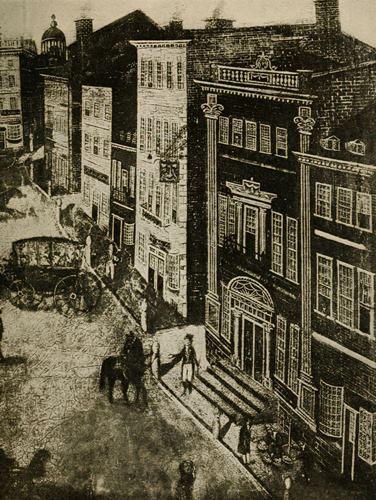
The Royal Exchange Tavern (white building at center) on State Street, where Hewes taught cane fencing three days per week
In a 1799 advertisement Hewes further stated that with his “system of defence…a person attacked can defend himself against the Small Sword, Broad Sword, Sabre, Gun and Bayonet, cane or small Stick of Wood.” Later notices by Hewes added the “spaderoon,” “Claymoor,” and “rapier,” to the list of weapons taught, and the “boarding pike” to the list of weapons which the cane was capable of defending against. Hewes further explained:
“According to the present appearance of things, and as Effeminacy forms no part of the American Character—Mr. HEWES has Reason to Expect a full Employ—even Invalids had better Learn to wield the Sabre, than swing the Dumbells—for health, Rosey health is in Exercise found.”
In 1798, Hewes also offered to teach “the true Highland stile, as taught by the late famous Donald McAlpin.” An avid collector of fencing treatises (his bookshelf contained Angelo’s, among others), Hewes later claimed to have united the “French, Scotch, and Austrian Methods into one System.” Regarding the specific use of the cane, which he typically referred to as “Cane Fighting, or the Art of Personal Defence,” Hewes stated:
“Some private gentlemen content themselves with carrying a large knotted cane—cost perhaps five dollars. All that may be very fashionable and very well; but a little attention and practice with Master HEWES, at the head play and knock-down lessons, would make that cane look more graceful, and feel more agreeable in the hand than before…Other private gentleman will not carry a cane, or any other weapon of defence—but depend upon their own good behaviour and civil deportment for protection; which is really a good sentiment, and will almost always answer the purpose: But there are times when all that goodness will not protect them against the attacks of a ruffian, but be rather an incentive… therefore the art of defence is necessary.” (Columbian Centinel, Oct 27, 1802)
Hewes would go on to republish a number of books on fencing and military tactics, including the 1796 saber treatise, Rules and Regulations for the Sword Exercise of the Cavalry by Major-General John Gaspard Le Marchant, which, according to the title page, Hewes had “revised and corrected.” Later in the century, Hewes’s edition did not escape the notice of fencing scholar Egerton Castle, who included it in the bibliography of his landmark Schools and Masters of Fence, from the Middle Ages to the Eighteenth Century.
Given that Hewes frequently relates his method of cane defense to fencing with the broadsword and saber in his numerous advertisements, it is worth taking a brief look at the Rules and Regulations. The text describes six cuts, eight guards, “the modes of parrying,” and defense against cavalry, bayonet, as well as “the defence of one man against two.” It notes that all cuts are to be made from the wrist, “without giving action to the elbow,” and exhorts practitioners
“not to hold their swords too tight; but to allow the hilt to play in the hand, by the second, third, and fourth fingers being distended or contracted, as may be necessary to accord with the motion of the blade; taking care invariably to hold the gripe firm with the fore-finger and thumb.”
Hewes felt strongly enough about his edition to send a copy to President Thomas Jefferson, to whom he urged its adoption in the American military, complaining that “our Cavalry are truely Millitary Monsters haveing no Sistem of Exercise.”
Hewes continued to teach cane defense, as well as fencing “in all its various branches,” for several decades in the Boston area, posting his last known advertisement in 1826. One of his last notices contains an eloquent passage on self-defense training, interspersed with Hewes’s characteristic humor:
To cure the body the mind must be pleased by the exercise—for instance, learning the art of defence…has restored many young gentlemen in this city to health and strength. The mind being pleased with the theory, the body naturally gains strength with the practice, and when masters of the art, they may defend themselves scientifically, save their limbs and perhaps their lives by their skill. But some will say that in a government like ours, the law is our protection—in carrying a civil deportment and gentleman-like appearance we are safe enough; a great mistake in both arguments. In the first place, the law cannot protect you at the moment of attack, is expensive and troublesome, and you cannot expect to have a constable always at your heels, padding after you, like Corporal Trim after Uncle Toby. In the next place, your mild and genteel appearance, does not but invite the attack of the foot pad or ruffian; they mark you as their prey, as the hawk does the dove…therefore the art of defence is necessary, and if you come and learn, it will answer two good purposes, viz: it will cure you of bodily weakness and me–of the Mal de Pouch, if you pay me for it, as Lope Toco says to Roque. Please apply to ROBERT HEWES, Corner of Essex street, where he practices the art of Bone Setting—or at his Fencing Room, Boylston Market, where he teaches the art of Bone Breaking—genteely.
Hewes’s many business ventures seem to have paid off, for in later years he was regarded in Boston as a “gentleman of leisure,” living in a “large house, with a spacious court, and magnificent shade trees” on the corner of Essex and Washington streets. He also became known as something of an eccentric, and was often seen in his dressing-gown “playing with the peacocks and paroquets in his yard.” It was related that in 1826, he told his housekeeper, Sally, “I am 75 years old today, and I can handle a broad sword better than any young man in Boston.” Hewes passed away in 1830, and is buried next to an unmarked stone in Boston Common.
THE NINETEENTH CENTURY
The nineteenth century saw an explosion in the number of cane fencing instructors in the United States. That the walking-cane was employed in earnest in street encounters can be verified by a number of news reports, of which the following is only one example:
“Baltimore, Feb. 2. An attack was made upon a gentleman last evening about nine o’clock in High, near Stiles street, no doubt with the view of obtaining plunder—the gentlemen received a severe blow over his right eye, but being somewhat on the lookout, made a good defence with his cane—the ruffian then attacked him with large stones, but was compelled to retreat into an alley between Albermarls and President streets and thus effected his escape.” (New York Evening Post, 1830)
In the years following the appearance of Robert Hewes, a number of other instructors in “cane defence” and “cane fighting” publicly offered their services. Seven of these individuals appear to trace their fencing lineage to a single source: the Military School of Colonel Irénée Amelot De la Croix.
COLONEL DE LA CROIX
De La Croix was a former nobleman of Flemish, French, and German ancestry, a member of the ancien régime, and a decorated military veteran. His voluminous 1814 biography describes many of his incredible feats and adventures, noting that in the course of his career, the Colonel had impressively “been fourteen times wounded severely…and has been in fifty-six regular battles, besides near fifteen hundred affairs of out-posts and skirmishes.” (Baron de Vanden Boègard, Portrait of Colonel I.A. de la Croix, Baltimore: Printed by Bell & Cook, 1814). De La Croix arrived in the United States in 1806, where he “married an American lady” and opened a military school in Boston, “where he taught many.” Later De La Croix moved his school to Newburyport, then to Portsmouth, New Hampshire, and from thence to New York City and Baltimore. In New York alone he had “thirty scholars.” During his time in America, he authored several treatises on the art of warfare, and corresponded with Presidents Thomas Jefferson and James Madison.
At least seven of the Colonel’s former students, or students’ students—including Michel (later William) Tromelle, Jean B. Girard, Phillip Haussy, Mr. Nichols, Peter Trinque, Thomas Ryan, and George Gray—would go on to teach “cane fighting,” sometimes referred to as “Norman cudgelling,” the “Norman mode of defence,” or, as Nichols stated simply, “a powerful defence with the cane” (curiously, Trinque and Haussy would at one point describe it as, “the mode of using the single Stick, as practiced by the Romans”). An advertisement by Tromelle, published in Boston in 1810, described De La Croix’s system, and its benefits, as follows:
“The great advantages attendant upon this mode of defence, and the benefits arising from these lessons, where persons are exposed to the insults of disorderly and unprincipled men, as well as an attack by a desperate villain, must be a sufficient argument to attract the attention of most men. It is a fact generally credited by gentlemen who have a knowledge of this defence with a cane, that a person is capable of conquering an attack of six men (with the same weapons), if they should not have a knowledge of this play. And to substantiate this fact, we have been very credibly informed that a gentleman who was taught the Norman mode of Defence, in Boston, has obtained a considerable sum of money by overpowering and driving three as hardy and courageous men as could be obtained to combat against him. We further have the pleasure of asserting that gentlemen who have become acquainted with the Stick Fighting feel more than amply rewarded for all their time and money spent in learning.”(Columbian Centinel, Oct. 6, 1810)
As De Le Croix’s students refer to his method as “Norman,” it may be that it was an early form of, or precursor to, French La Canne. However, as the specific techniques of formal systems of La Canne were not documented until the early 1840s, it is difficult to say how much De La Croix’s method may have resembled mid-nineteenth century French systems. As noted previously, cane fencing had certainly existed in France long before this time, where it took on different forms. According to his biography, De La Croix had studied at the military schools at Chalons, Metz, and Brienne, and served in the French Marines—a fact which may give insight to future researchers.
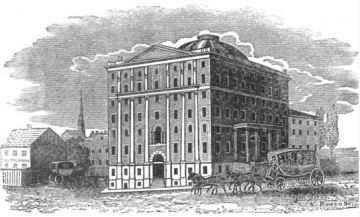
The Exchange Coffee House in Boston, where De La Croix’s students Tromelle and Girard publicly demonstrated cane self-defense
Whatever the case, students of De La Croix’s cane method nearly always stressed its efficacy in combating large numbers of simultaneous attackers. Jean B. Girard, one of De La Croix’s first assistant-instructors, explained,
Mr. Girard will…teach Cudgelling, in the Normand manner, not yet known in this country. If the American gentlemen were acquainted with the utility of this manly exercise, how easily it is obtained, he feels sensible that he would meet with great encouragement; as he has no doubt, that he can enable a pupil, in three months, to make an effectual defence against six assailants. (Boston Commercial Gazette, Nov. 16, 1809)
In 1812, in Baltimore, at a demonstration of “stick exercise or cane fighting” given by “Tromelle & Co.,” it was stated that
“A proficient in the stick exercises, may defend himself with safety, from the attack of four with broadswords at the same time.”
And in 1813, a former Baltimore student of De La Croix, George Gray, gave demonstrations in pugilism, fencing, and the “Norman cane,” and the next year, opened a fencing school in Lancaster, Pennsylvania, of which he noted,
“A proficient in the Norman cane exercise will defend himself against the attack of six men at the same time with the same weapons.”
As late as 1824, Gray’s former colleague, Thomas Ryan, was teaching “Boxiana” and “the use of the cane” at his own School of Arms in Baltimore.
In 1818, after parting ways with fellow instructors Jean Girard and Peter Trinque, the aforementioned William Tromelle took to the Boston press to announce his “co-partnership” with a new fencing master—Antonio Cannata of Italy. Together, Tromelle and Cannata would teach defense with the “stick,” as well as “fencing, in all its various parts” for the next year at No. 3 Cornhill Square. Of especial note is an advertisement published jointly by the two on April 21, 1818, in the Boston Daily Advertiser (see below). This notice contains a crude illustration, similar to those found in other American fencing advertisements of the period, except for one important difference: whereas others depict fencers engaging, or lunging, with clearly hilted foils or smallswords, the one published by Tromelle and Cannata shows two fencers facing each other out of lunge distance, with hiltless weapons—possibly sticks or canes. As this same advertisement listed the “Broad Sword,” “Small Sword,” “Cut and Thrust,” and “Stick” as weapons taught, this was certainly one of the possibilities.
Although, given the crudeness of the illustration, it is difficult to say with certainty, this advertisement may possibly represent not only De La Croix’s method of “Norman cane,” but the earliest visual depiction of cane fencing technique published in America.
Roughly one year later, in the spring of 1819, Cannata parted ways with Tromelle (possibly due to the ill-health of the latter, who would pass away in 1822), and announced the “re-opening” of his own solo school. An advertisement for Cannata at this time shows a different image, of fencers lunging and parrying with hilted swords.
OTHER FRENCH INSTRUCTORS
Another French instructor that appeared in America about this time—though not connected to De La Croix—was G. M. Coulon, who, in 1826, “lately arrived in [New York] city from England.” In 1827, Coulon announced the following in the Evening Post:
“The manly foils and broadsword taught upon the most approved method by Mr. C. every Tuesday, Thursday, and Saturday…Self defence with a stick, against any ruffianly attack, taught in six lessons.”
Unfortunately Coulon’s school was not to last, as he unexpectedly passed away in November of the same year.
The years between 1837 and 1840 saw a number of additonal French fencing masters advertising the “use of the Cane and Stick.” The first was François George Baugé, of New York City and Charleston, and who produced at least two subsequent cane fencing instructors, Charton and Chabriel, all originally “of the Royal Academy of Paris.” Although Baugé published a series of illustrations on the art of fencing, these did not, unfortunately, include the cane. Other French instructors of “cane defence” during this same period was H. Hautonville, who appeared in Charleston in 1840, and E. Raux, who ran an “Academy of Arms” in Richmond, Virginia, in 1849 . These individuals all neglected to describe their methods of cane defense, and may very well have been teaching French La Canne, the technique of which would begin to be documented in France during the 1840s.
Approximately two decades later, in 1865, a Captain Arthur De Pelgrom, a Belgian who had evidently instructed soldiers in the Union Army, also offered practical self-defense in the use of the walking stick:
At the same period, a few instructors hailing from other nations appeared, who deserve mention.
SIGNOR MANFREDI
Another colorful character worthy of mention, and who hailed from Italy, is “Signior Manfredi,” described as an “Artist of Agility,” and “astonishing man who has lately arrived in this country from Saddlers Wells,” who performed feats of strength and balance, as well as demonstrations of cane defense.
Manfredi, who claimed to have previously exhibited in London, Saint Petersburg, and Constantinople, gave demonstrations in the American cities of Portsmouth, Albany, New York City, Philadelphia, Baltimore, Norfolk, and Charleston from the years 1803 thru 1808. As Manfredi’s events were billed as a “Grand Display of Entertainment,” and also included “tumblings,” “feats of strength,” “tricks,” balancing acts, feats on horseback, and other acrobatics, it is unclear whether Manfredi’s stick demonstrations were actual exhibitions of self-defense techniques, or were merely staged entertainments. Whatever the case, audiences were impressed:
Signor MANFREDI has indeed already performed feats calculated both to “surprise and astonish.” The manner in which he went through his exhibitions on Monday evening was in the highest degree satisfactory to the audience, who testified their opinions by repeated and long-continued shouts of applause. He is so evidently a master of his business, and with such entire ease and dexterity does he requit himself, that the spectator may view his feats without having his sensations of pleasurable emotion disturbed by apprehensions for his safety.
Curiously, in one Maryland advertisement, Manfredi’s stick is described as “Dutch” rather than Italian. Most of Manfredi’s notices mention the use of the stick against multiple opponents—a feature which echoes the advertisements of De La Croix’s many students.
CAPTAIN RYLISKI
Captain Alexander Ryliski of Poland was another obscure figure, who taught cane defense in New Haven, Connecticut, at No. 31 Barney Hall on Chapel Street. Lest anyone doubt his experience, Ryliski noted in his advertisements:
“As a guaranty that Mr. Ryliski understands perfectly the above arts, he would only remark that for fifteen years he has served as an officer in the Polish army.” January 7, 1839, New Haven Daily Herald
Interstingly, Ryliski noted that he kept two separate schools—one a designated “Fencing School,” in which he taught the foil, broadsword, and bayonet, and the other “a School for exercise with the cane, for self defense against many.”
MAJOR R. I. DUNN
“Against Swords, Dirks, or Bowie Knives”
A particularly notable cane instructor of the same period was Major R. I. Dunn, “Professor and Teacher of Military Science,” a former citizen of Ireland who would become a noted American military officer. Although Dunn had begun teaching fencing in America in 1812, it was not until the 1840s that his military academies in New Orleans, Virginia, Massachusetts, and Kentucky became well-known. In an advertisement for his New Orleans academy, Dunn claimed that his “art of Personal Defence,” or method of fencing
“is a combination of the broad sword, small sword, single-stick or quarterstaff, with the manner of disarming an antagonist…and renders [the practitioner] fully capable of attacking and defending himself against sword (broad or small), bayonet, dirk, or stick, and when even only armed with a walking stick.”
An 1847 advertisement for Dunn’s school in Frankfort, Kentucky, appropriately added the “Bowie knife”—a popular local sidearm—to the list:
The particular mention of the cane used to defend against a Bowie knife is an unusual one, prompting one to wonder if such encounters in earnest ever actually occurred. The answer is yes. According to the Baltimore Sun of August 14, 1856, when one Edward Morton ambushed a Mr. Ben Debar in the streets of St. Louis,
As Debar passed [Morton] jumped out at him and endeavoured to stab him with a Bowie knife; DeBar’s alertness and skill at fencing saved his life. He knocked off the blow with his cane, and then grappled Morton until a policeman came.
It appears that Major Dunn himself had experience using the cane to defend himself in serious combative encounters. In what can only be described as a highly unusual occurrence, the Major is reported as having engaged in a pre-arranged combat with canes and pistols, fought in earnest. According to the May 24, 1844 issue of the Richmond Whig:
A rencontre took place at the Prentiss House, between Major Dunn, well known in this City as a teacher of the art of boxing, fencing, cudgel playing, &c. and Major Anderson Miller with Canes. Dunn it seems wielded his stick “most scientifically.” The parties afterwards met and fired at each other with pistols, but without effect.
In 1841, Dunn published his Condensed Military Pocket Manual. This book contains a chapter on the “Infantry Sword, or Cut and Thrust,” on which Dunn largely based his method of cane defense—with the important modification of eliminating all thrusts while using the cane. Dunn mentions that the infantry sword is lighter than that used by the cavalry, and thus, “much more agility is necessary.” He includes six cuts and a number of “guards,” including “the position of St. George.” Dunn instructs his readers as follows:
The position of the [fencers] will be fronting each other, and placed about four full paces apart, the right foot will be advanced about half a pace, the point of the toe, sword-arm, and right side only, presented to each other, the left hand on the hip, arm a-kimbo, swords crossing each other, in a diagonal position, taking care to keep the sword-hand on the right eye as much as possible, which is the general guard; the cuts will be made with a stiff arm, using the wrist instead of the elbow… When the opponent is a strong and vigorous man, and assaults with rapidity, act on the defensive, retreating a little if too hard pressed; but on discovering that he begins to slacken or get fatigued, then will be the proper time to become the assailant with advantage.
The book contains a small passage on the specific application of these techniques to the cane, which notes an interesting method used to protect one’s hand and fingers:
“In the exercise and use of the cane…the same rules will be adopted as in the cut and thrust sword, with the exception of giving point, which will be unnecessary. It will be advisable (if there should be time) to wrap the hand embracing the cane in a pocket handkerchief, which will guard the knuckles and secure the cane at the same time; the handkerchief must not be tight, as it would confine the cane too much, but crossed lightly from right to left, over the hand.”
COLONEL THOMAS H. MONSTERY
“Almost anything can be made into a weapon if properly used…”
Colonel Thomas Hoyer Monstery was one of the most celebrated American fencing masters of his time, and the first to write extensively about the use of the cane as a method of self-defense. When it came to combat, Monstery had an impressive resume. He had fought under twelve flags in numerous wars and revolutions, had survived participation in more than fifty duels with the sword, knife, and pistol, and had twenty-two scars on his body to prove it. In 1878, Monstery expounded upon his method of cane defense in a series of articles published in the New York press, following his chapters on boxing, grappling, and kicking. More specifically, Monstery treats of a hickory walking-stick, which he describes as “the proper companion of every gentleman”—good against knives, sword-canes, and even guns:
“Boxing will get a gentleman out of a great many scrapes into which he may fall, but in some parts of the Union he will come across men who habitually carry knives or pistols and in such a case a stout walking-stick, if he knows how to use it, may save his own life, and—what I consider more important—prevent the necessity of his taking the life of another. It may seem strange to some that I, who have passed my time in the profession of arms, and have lived so much in Spanish-America, where the use of weapons is universal and duels of everyday occurrence, should have a horror of taking life; and yet I can honestly say that I have always avoided it, except where there was an absolute certainty that the question lay between my own life and that of another who sought to kill me…Many are the pistols and knives that I have struck from the hands of men by a smart blow on the wrist with a cane, and many are the murderous brawls I have prevented in this way. As a queller of disturbances, I know of nothing better than a hickory or ash stick.” (Chapter 12)
To prove the cane’s efficacy as a personal sidearm, Monstery includes a thrilling anecdote regarding an incident when he was attacked by three knife-wielding members of the Spanish secret service, who were intent on assassinating him. Using only his hickory cane, Monstery was able to successfully defend himself, until his attackers eventually fled into the night.
Monstery describes his cane system as being based on the same fencing principles as the saber or broadsword, but with some important modifications to account for the lack of a guard to protect the hand. The parts of the body that he targets are also different than those targeted with the sword, due to the concussive (rather than cutting) nature of the cane. Monstery also notes:
“The hook is an important part of the cane. It doubles its usefulness, serves as a handle to rest on when it is used as a staff, prevents its slipping out of the hand when it is used as a weapon, and serves as a sling when you do not wish to handle the cane. With a hook to his cane, no man need ever abandon it, for he can always hang it over his left arm when not in use, so as to be ready to catch it instantly with the right.” (Chapter 12)
Monstery also eschews the use of single-handed thrusts, which, he states, are “easily parried,” expose the fencer, and can only hurt or disable an opponent in two spots. Although Monstery notes that the case is different with two-handed thrusts, he reserves these techniques for his subsequent chapters on the use of the quarterstaff.
Throughout his life in America, in addition to his New York City academy, Monstery also ran schools in Baltimore, Oakland, San Francisco, and, in his final years, Chicago.
JUSTIN BONNAFOUS (1898)
In 1898, an article on cane self-defense was published by Justin Bonnafous, the American-born son of a French maitre d’armes of the same name. The elder Bonnafous had been a well-known “sword master” at the United States Naval Academy at Annapolis, Maryland. In 1883, Bonnafous Jr. succeeded his father as instructor at the Fencing and Sparring Club of Philadelphia, where he would continue to teach for several decades. In 1898, after having traveled to and returned from Paris, where he had studied fencing, Bonnafous authored a short treatise on self-defense with the cane. It was published in Volume 31 of Outing magazine, and accompanied by nine photographs. Bonnafous’s method shows the influence of French la canne, and includes techniques to defend against knife-wielding thugs as well as multiple attackers, and utilizes both single and double-handed grips. Following is one of several techniques described by Bonnafous:
“If an assailant comes at you armed with a knife or razor, cut for the arm, and, on his dropping it, proceed with treatment as before (see Figures 5 and 9). The thrust for the eye is sometimes used, but should only be resorted to as an extreme measure, for it might prove fatal.”
Bonnafous directs the reader to use a cane “of thoroughly seasoned, straight grained hickory, tapered like a billiard cue, about one and a half inches at the butt, down to three-fourths of an inch at the point. The butt should be surmounted by a knob of silver or other heavy metal, and the point protected by a heavy ferrule.” Unlike Monstery, Bonnafous cautions against using a cane with a hook, for, he warns, “it is apt to become entangled in the clothing at the critical moment, and in such melees every second counts.”
Bonnafous’s article, as far as we currently, know, is the last to treat of cane defense during the nineteenth century.
THE TWENTIETH CENTURY
LOUIS TRONCHET
“The complete defense that lies in a cane…”
Louis Tronchet, a French maitre d’armes, arrived in the United States in 1887, and by April of 1888, had moved from New York to San Francisco, where he began giving fencing lessons at the distinguished Olympic Club, which had been co-founded by Monstery. Tronchet was an exponent of the French school of classical fencing, and had graduated from the military academy of Joinville-le-Pont at the head of his graduating class numbering six hundred. According to his colleague (and occasional rival) Henri Ansot, Tronchet dismissed “wild fencing” in favor of “the more classic style of fencing,” which soon “took the supremacy, under his correct and graceful style of tuition.” This style had evidently served Tronchet well, for in 1887 he defeated the noted New York fencing master Regis Senac in a prominent contest at Cosmopolitan Hall, while adhering throughout to a “faultlessly classical position.”
Tronchet was also a known expert at French savate, and offered instruction in cane self-defense for use in the street. In 1903, after teaching, contesting, and demonstrating fencing in the United States for more than fifteen years, Tronchet published several techniques of cane self-defense in the pages of the San Francisco Call, showing how to ward off several types of armed attack by a “footpad or ruffian.”
“It has remained for Professor Tronchet, instructor of fencing at the Olympic Club, to teach the complete defense that lies in a cane.”
The article, however, does not cover such a complete defense, but, rather, “illustrates a few of the simpler movements and foils which with little practice can be made use of to the advantage of Mr. Footpad by any man of average strength and adroitness.”
The article thus shows a handful of cane defense techniques, utilizing both single and double handed grips, and mostly executed versus a masked attacker armed with a pistol. Tronchet instructs the person accosted to put his hands in the air in a gesture of surrender, but all the while still holding the cane—assuming a position of readiness designed to give the illusion of submission. He proceeds to describe various ways to attack the shins, wrist, and head. For instance, Tronchet instructs,
The simple blow on the wrist is as effective as any blow can be. A right swing of the body and a quick, strong blow across the wrist with the cane causes the footpad’s hand to instantly relinquish the weapon and leaves an opening for an attack with the advantage in favor of the peaceful homegoing citizen. However, he is not quite ready for the homegoing yet. He prefers to see his footpad eating humble pie first.
After advocating several such defenses, including the use of a head butt, throws, and chokes, the article notes that
Professor Tronchet has many more swings and thrusts and tilts of the simple walking cane wherewith to bring the footpad to confusion, but the more difficult ones would require much practice and a close perusal of the rules set down in some pamphlet on fencing…as steady nerve, a cool head, and a quick action are the three requisites–given the walking cane and the ability to use it properly.
The article thus concludes,
Should the cane become a popular weapon of defense against footpads, and according to Professor Tronchet, there is no reason why it should not, it will be necessary for the footpad who wishes to be successful in his chosen profession to take the art of fencing. Otherwise he will find it pleasanter to earn his own living than to depend upon others to earn it for him.
BARTITSU (1903)
“When a man is called on to face a ruffian, he needs no better weapon than a hickory walking stick…”
Bartitsu was an English hybrid martial art developed by Edward William Barton-Wright, and which was practiced in Great Britain between the years 1898 and 1902. Although relatively short-lived, the techniques of Bartitsu were documented extensively in various journals and magazines, which saw widespread distribution. Although much of Bartitsu’s unarmed techniques (particularly grappling) were borrowed from Japanese martial arts, its method of cane self-defense was largely influenced by a style of la canne developed by the Swiss maitre d’armes Pierre Vigny.
Although, as far as we know, Bartitsu was never practiced in America (prior to a late twentieth century revival), its techniques did see publication in America, and are worthy of mention. On August 30, 1903, a lengthy illustrated article appeared in the New York Tribune, under the following heading:
“SCHOOLS WHERE MEN ARE TAUGHT HOW TO DEFEND THEMSELVES AGAINST THE ATTACKS OF STREET ROWDIES”
The piece was accompanied by seven illustrations, excerpted from The Illustrated Sporting and Dramatic News, a British journal. The text of the Tribune article, however, is original, and offers a fascinating glimpse into how New Yorkers viewed the criminal threat at the turn of the century, as well as emphasizing the importance of learning self defense with a cane:
When a man is called on to face a ruffian, he needs no better weapon than a hickory walking stick. A revolver is likely to harm him more than to help. As soon as a man reaches for his weapon, his adversary has the right to shoot, and the accomplished criminal is almost sure to have his weapon ready first. The stick is the better weapon, because it is quicker. It is in one’s hand already. It is always “loaded”…Should a New-Yorker combine both the tactics of the London stick man and the United States naval wrestler, it is safe to say that the police of this city would have far fewer holdups and burglaries to record than at the present time.
The article also offers an interesting look at the perceived fighting styles of various local “thugs” of Anglo-Saxon, Spanish, Italian, and German origin, and offers advice for defending oneself against assaults with the fist, foot, stick, knife, and gun.
MARQUIS OF QUEENSBERRY (1911)
“One advantage of the cane as a weapon is the facility with which a blow may be delivered…In fact, a blow may be delivered with a cane perhaps almost quicker than with the fist. For this reason such a blow is hard to dodge.”
In 1911, another instructional article on self-defense with the cane appeared in the pages of the Chicago Tribune. The author, writing under the name of “The Marquis of Queensberry,” was none other than Lord Percy Sholto Douglas (1868-1920), 10th Marquess of Queensberry, and the second son of John Sholto Douglas, the Scottish nobleman best known for lending his name and patronage to the “Marquess of Queensberry Rules” that formed the basis of modern boxing.
Most of Douglas’s previous columns pertained to boxing and jiu-jitsu; he did, however, include one on self-defense with the cane, and another on the use of the umbrella or parasol (intended for women), both of which were accompanied by a number of photographs, some of which included Douglas himself, and drawings. Like the methods of Hewes and Monstery, as well as the cane techniques set down by fellow Briton R. G. Allanson-Winn, 5th Baron of Headley, Douglas grounded his cane defense firmly on the fencing techniques normally applied to the broadsword and saber.
Douglas’s articles are highly interesting, and probably most useful in their simplicity. They are intended for a general audience, as well as for fencers looking to apply their preexisting knowledge of the sword to common household articles such as the cane and umbrella. From a pedagogical standpoint, Douglas’s series is perhaps also notable for its inclusion of footwork diagrams in its section on the umbrella.
ANDREW CHASE CUNNINGHAM (1858-1917)
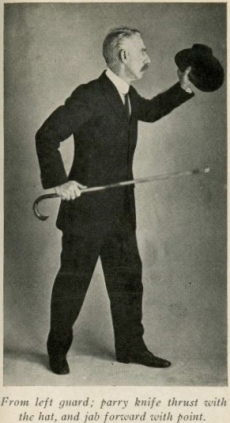 In 1912, another treatise on cane self-defense appeared, published in the form of a short pamphlet by Andrew Chase Cunningham of the United States Navy. Much has already been written about this text, which is also widely available. Suffice it to say that Cunningham was president of the Washington D.C. Fencing Organization, and the author of a fencing text, Sabre and Bayonet (1906). According to this article by Maxime Chouinard, Cunningham had been a student of the elder instructor Antoine J. Corbesier, who had served in the Belgian and French militaries before immigrating to America, where he became instructor at the U.S. Naval Academy in Annapolis, Maryland. According to Chouinard, Cunningham’s cane defense techniques bear some resemblances to Corbersier’s method of Belgian Canne Royale. Cunningham’s The Cane as a Weapon contains eighteen pages of text, as well as twelve photographs.
In 1912, another treatise on cane self-defense appeared, published in the form of a short pamphlet by Andrew Chase Cunningham of the United States Navy. Much has already been written about this text, which is also widely available. Suffice it to say that Cunningham was president of the Washington D.C. Fencing Organization, and the author of a fencing text, Sabre and Bayonet (1906). According to this article by Maxime Chouinard, Cunningham had been a student of the elder instructor Antoine J. Corbesier, who had served in the Belgian and French militaries before immigrating to America, where he became instructor at the U.S. Naval Academy in Annapolis, Maryland. According to Chouinard, Cunningham’s cane defense techniques bear some resemblances to Corbersier’s method of Belgian Canne Royale. Cunningham’s The Cane as a Weapon contains eighteen pages of text, as well as twelve photographs.
DR. BENJAMIN FRANKLIN ROLLER (1915)
“Nothing justifies fighting at any time or place except defence.”
In 1915, bodybuilder and physical culturalist Dr. Benjamin Franklin Roller, M.D., published a series of articles on exercise, diet, healthy living, and self-defense in the New York press. Roller propounded a unique unarmed method of self-defense, which combined savate, boxing, Cornish wrestling, and American catch wrestling (this last being Roller’s specialty) for use against unarmed assailants, as well as those wielding a knife or gun.
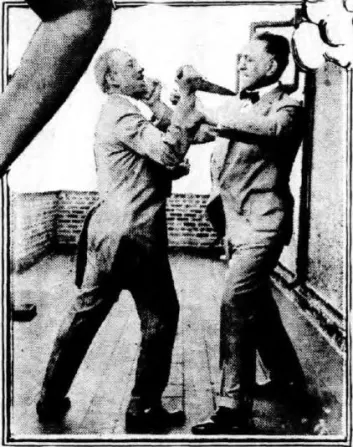
Roller’s unarmed defense against knife: “Parry the stabbing arm with the palm of the left hand. Step boldly inward, forward, and to the left. Spring from the right foot and throw the entire weight, of the body behind a right hand blow to the assailant’s chin.”
In addition, Roller describes what he considers to be the “Eight Essential Exercises,” which includes fencing:
Eight things should every boy be able to do (until he can do every one of them fairly well he is not a man complete)—to run, to jump, to ride, to shoot, to wrestle, to box, to swim and to fence. You don’t have to be an expert in all, or even in any one. These are the fundamental studies of self-defence, and the more you can learn about all of them the more you will increase in ability which some time you may badly need.
Regarding fencing in particular, Roller explains:
Fencing is one of the most beneficial of exercises, great fun and a very effective means of defence. Get the singlesticks, with mask and glove, at any sporting goods house, or you can practise the movement with any old stick. I never took a lesson in this work in my life, but I became so efficient in singlestick fencing that I defeated the best professional fencer on the Pacific coast and twice saved my life by knocking a gun or a knife out of an assailant’s hand by means of an ordinary cane.
The vast portion of Roller’s instructional material treats of his special hybrid method of unarmed self-defense. He does, however, describe and photograph one technique using a hooked cane:
Roller explains this technique as follows:
“Fig. 4.—-A fencing stroke in self defence. The author saved his life in Indiana once by this exact stroke, disarming the assailant and breaking his hand. Step backward and a little to the left. Execute a complete circle from below upward and to the left with the forearm and wrist. The movement is as quick as a flash and very powerful if executed chiefly with the wrist, the elbow being elevated slightly to make the blow more effective.”
GEORGE HEINTZ (1920)
“The cane is the most practical form of sword play for use in those tight places where men care nothing for rules…”
In 1920, another treatise was published containing self-defense techniques applied to the cane. The author was George Heintz, Junior, an instructor at the United States Naval Academy, who included his method in the Naval Academy’s Manual of Athletic Requirements. A number of sources indicate that Heintz had learned fencing from his father, George Heintz, Sr., a German immigrant who had also taught fencing at Annapolis, Maryland, and was well-known in German fencing circles and Turner societies. His son, George Heintz Jr., was a national saber champion in 1890, and was appointed Assistant Swordmaster at the Naval Academy in 1903, taking over as Head Swordmaster from his father in 1915.
In his text, Heintz, Jr., propounds a method that is heavily based on fencing theory, and which is executed “in the same manner as [the] Sword Exercise.” It utilizes a saber grip, moulinets, as well as double-handed parries and thrusts. He outlines his method as follows:
“Remarks. — The cane is the most practical form of sword play for use in those tight places where men care nothing for rules, but only want to make the most out of the weapon which the chance of the moment has put in their hands; should the weapon in hand be an umbrella, the most effective use of the same would be the thrusts with both hands. Bayonet tactics can also be used with the cane or umbrella, such as Long and Short Thrusts, combined with the use of the knee or foot.”
Following are a selection of plates from Heintz’s chapter on the use of the cane:
George Heintz Jr. continued to serve as “Swordmaster” and head instructor at the Naval Academy until 1932.
MARCEL CABIJOS (1893-1964)
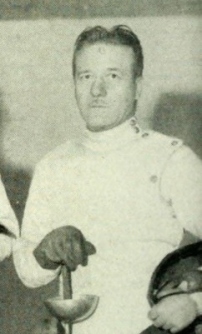 About this same period, another fencing master, of French origin, also began offering cane instruction in the northeastern United States.
About this same period, another fencing master, of French origin, also began offering cane instruction in the northeastern United States.
Born in France, in 1893, Marcel Cabijos served in the French Navy throughout World War I. He was a combat instructor and served in the Fusiliers Marins, a combat unit that was deployed to the land from ships. During his enlistment he founded a fencing society aboard his ship, and became the fencing champion of the French navy. After the war, he received his Maître d’Armes (master of arms) diploma and taught in the south of France for several years before emigrating to New York City in 1924. In addition to his rank as a fencing master, Cabijos was also an instructor in judo and savate. In 1926, Cabijos attained great renown by defeating the sabre and épée champion of the United States, Leo Nunes, with only a twelve-inch dagger against Nunes’s dueling sword.
In New York, Cabijos taught fencing at a large number of schools and institutions. Among these, Cabijos is recorded as having specifically taught cane self-defense at Vassar College, Lehigh University, the J. Sanford Saltus Club, and the Salle d’Armes Henry IV. The following article, culled from the archives of Lehigh University, and published in the magazine Brown and White, impresses upon the reader an idea of Cabijos’s prowess with the cane:
A number of accounts of Cabijos’s cane demonstrations appear in the Vassar Miscellaney, such as the following from February 2, 1929, which was held “before an enthusiastic gathering of about a hundred people”:
Again, in 1930, another account was published:
Unfortunately, as far as anyone knows, Cabijos never wrote any treatises or articles about his method of cane self defense. However, additional accounts of Cabijos and his fencing exhibitions can be accessed in the following collection on Pinterest.
FREDERICK ROHDES (1897-1984)
The history of cane self-defense in America would not be complete without mentioning Frederick Rohdes, a German fencing master who taught the art and science of fencing in New York City in the old tradition.
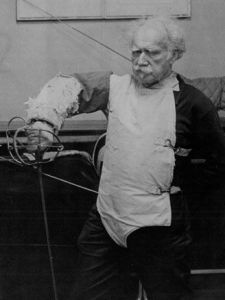
Maître d’Armes Frederick Rohdes, pictured with a schlaeger, one of the weapons taught at his academy, during the late 1970s.
Born in 1897 in Western Prussia, Rohdes taught fencing as an assistant instructor on the American west coast for some time during the 1920s before moving to New York City. He trained under several notable fencing masters, among them Maestri Luigi Barbasetti and Aurelio Greco eventually becoming Provost and Master under Marcel Cabijos (see above). Maître Rohdes opened his own fencing academy in 1948, which was located above the Loew’s Orpheum building on 169 East 86th Street in New York City.
Although he passed away in 1984, Rohdes’s fencing systems and techniques were passed down to his protégé Maestro Ramon Martinez, who continues to teach them today at the Martinez Academy of Arms in New York City. Among the many methods passed from Rohdes to Maestro Martinez include some techniques of cane self-defense. Maestro Martinez has since integrated these techniques into his own method of cane defense. For the purposes of this article, we asked Maestro Martinez to provide a description of his cane defense method. He responded,
“It is not a fencing system or a fighting system; it is a method of pure self-defense. However, it is informed by the knowledge of fencing that I have, as well as other personal martial experience. My objective is to keep it as simple as possible, so that it can be learned quickly. It is intended to be used against both armed and unarmed adversaries.”
POSTSCRIPT
In conclusion, it is important to note that the numerous fencing instructors and schools mentioned throughout this article do not, in all likelihood, represent a complete picture of what existed in America during the periods covered. It is highly probable that many instructors never advertised their services, and that there existed additional masters and instructors in America during these times who have escaped the eye of history altogether. It must be understood, therefore, that the corpus of surviving records represents a window through which one can glimpse only a part of the historical reality. It is to be hoped that, in the future, other researchers will uncover additional evidence of schools and masters of cane fencing in America.
Text of this article, except where quoted, © 2016 by Ben Miller.

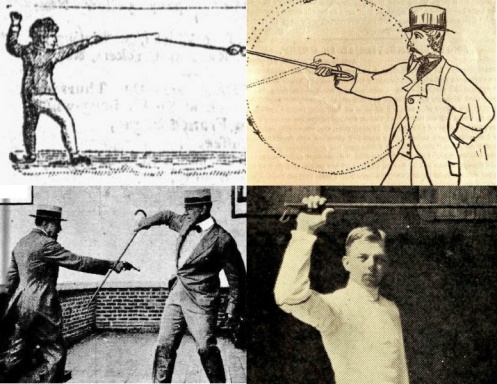
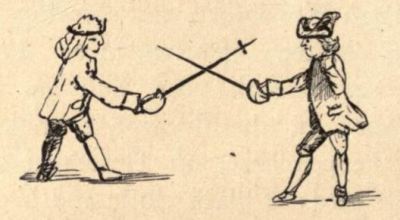
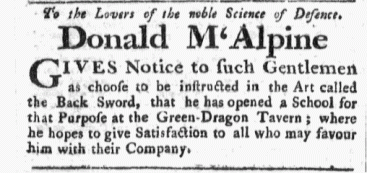
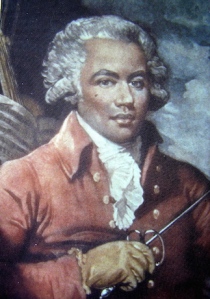

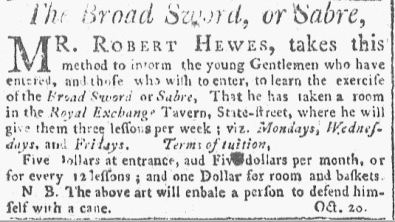
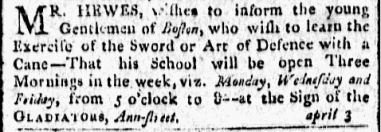
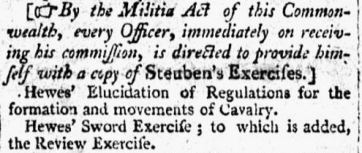

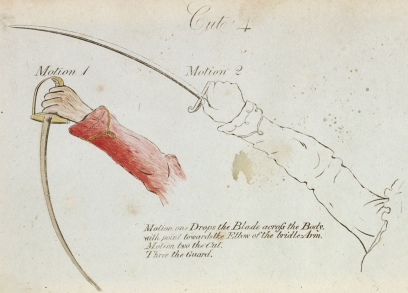
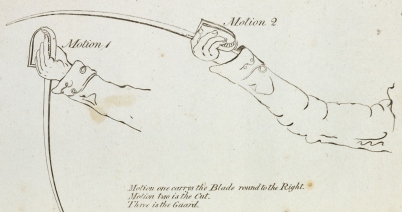
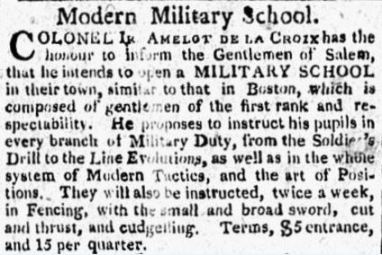

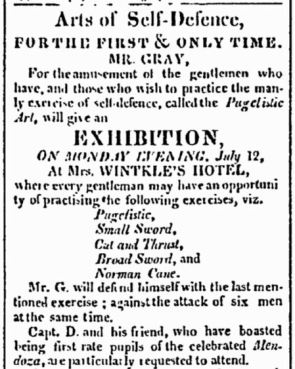
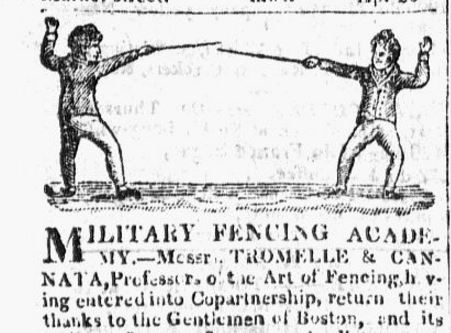
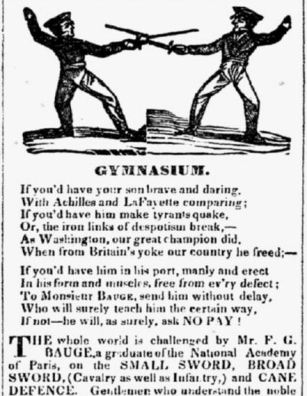
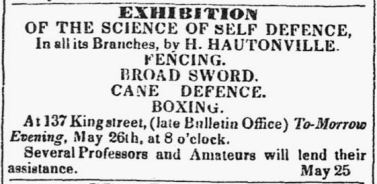
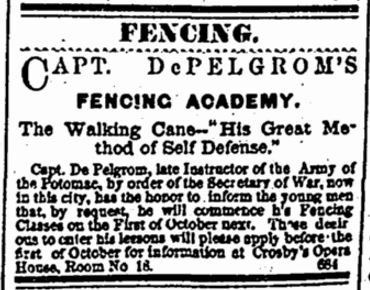

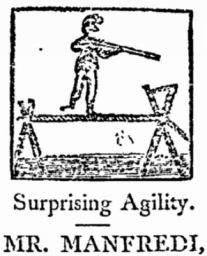

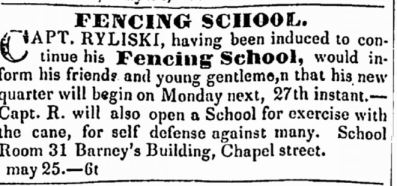
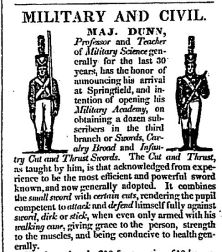
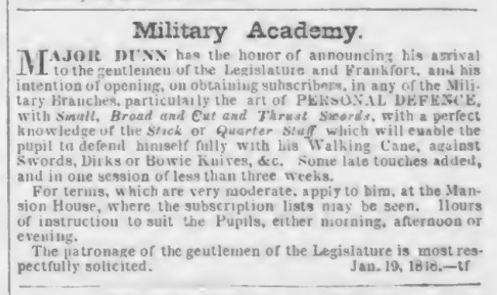

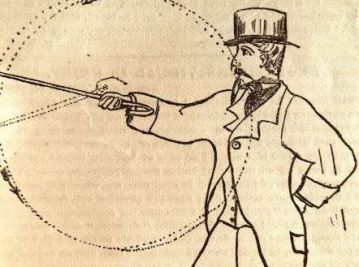
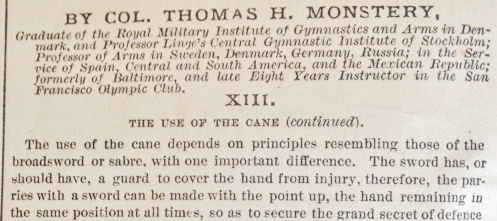


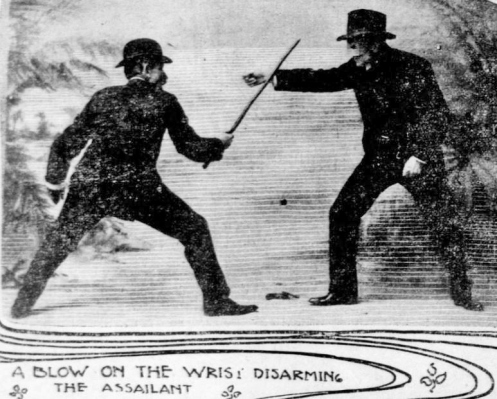
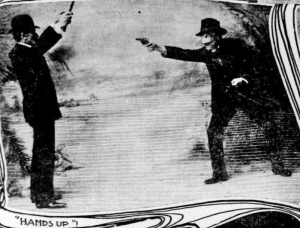
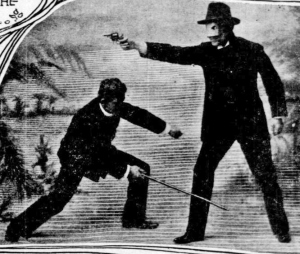
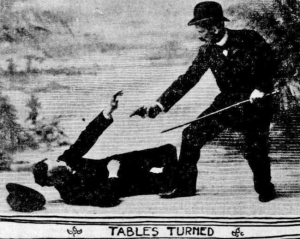
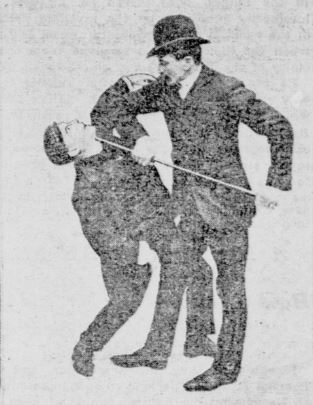
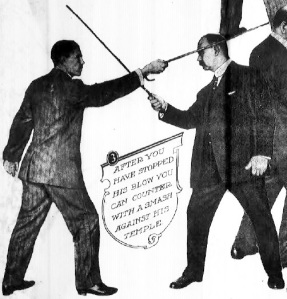

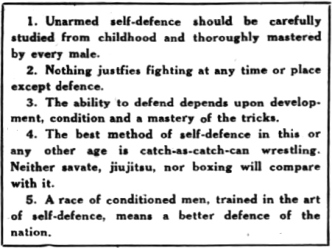
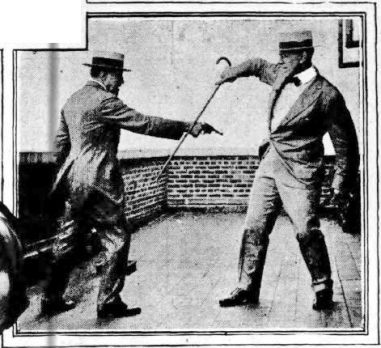
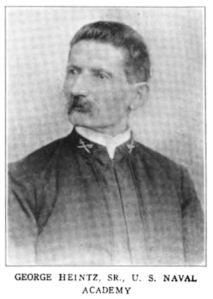
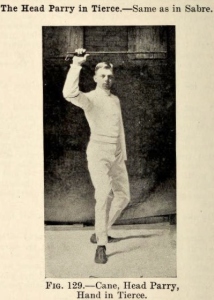
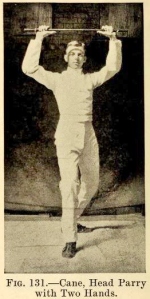
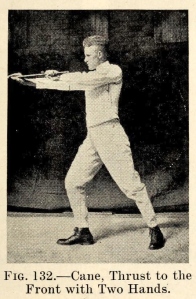
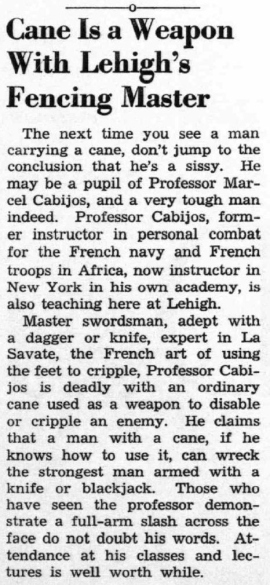

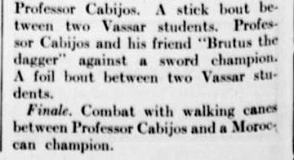

Reblogged this on Out of This Century and commented:
During the eighteenth, nineteenth, and early twentieth centuries, America could be a dangerous place, and knowledge of self-defense was often necessary for use in both urban and rural environments. To those ends, fencing masters and instructors often modified and applied fencing techniques to the cane or walking stick, creating their own systems of self-defense. This article proposes to look at various methods of cane defense, taught by fencing masters and instructors, that were specifically intended for practical use in self-defense encounters in the everyday world…
LikeLike
There is also the strangely Irish looking method of James I. Pearson. https://hemamisfits.com/2015/04/10/when-the-cane-is-mightier-than-the-sword/
LikeLiked by 1 person